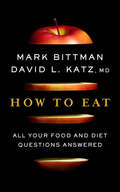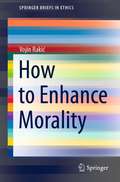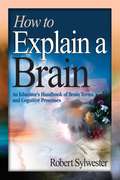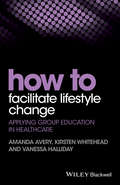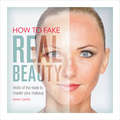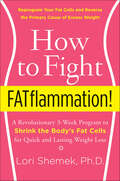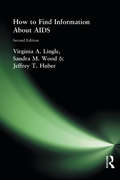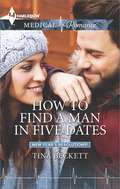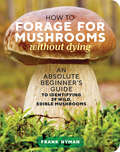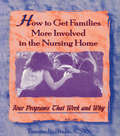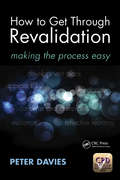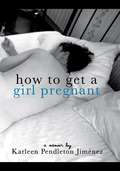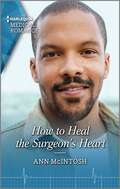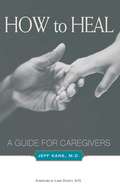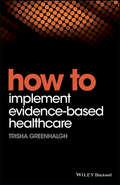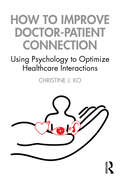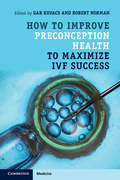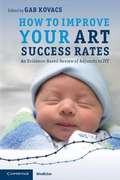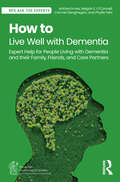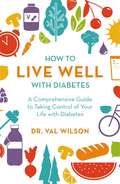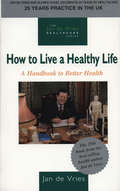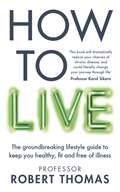- Table View
- List View
How to Eat: All Your Food and Diet Questions Answered
by Mark Bittman David KatzBestselling author Mark Bittman and physician David Katz cut through all the noise on food, health, and diet to give you the real answers you need What is the &“best&” diet? Do calories matter? And when it comes to protein, fat, and carbs, which ones are good and which are bad? Mark Bittman and health expert David Katz answer all these questions and more in a lively and easy-to-read Q&A format. Inspired by their viral hit article on Grub Street—one of New York magazine&’s most popular and most-shared articles—Bittman and Katz share their clear, no-nonsense perspective on food and diet, answering questions covering everything from basic nutrients to superfoods to fad diets. Topics include dietary patterns (Just what should humans eat?); grains (Aren&’t these just &“carbs&”? Do I need to avoid gluten?); meat and dairy (Does grass-fed matter?); alcohol (Is drinking wine actually good for me?); and more. Throughout, Bittman and Katz filter the science of diet and nutrition through a lens of common sense, delivering straightforward advice with a healthy dose of wit.
How to Enhance Morality (SpringerBriefs in Ethics)
by Vojin RakićThis book offers an innovative approach to moral enhancement. We, as humans, have a moral duty to be as good as we can be. Hence, moral bio-enhancement (MBE), if effective and safe, is our moral duty. However, it has to be voluntary because if it is made compulsory, human freedom (of the will) would be curtailed. As freedom (of the will) is an essential component of humanness, compulsory MBE would infringe upon our humanness.An essential question is; what will motivate humans to subject themselves voluntarily to MBE?The book argues - and supports by using empirical/experimental evidence - that morality and happiness operate in a circularly supportive relationship that applies to most humans most of the time: the better they are, the happier they will be; the happier they are, the better they will be. Hence, the grounding rationale for MBE ought not to be the prevention of “ultimate harm” based on compulsory MBE (as argued by Persson and Savulescu), but human happiness based on voluntary MBE. The primary objective of the book is to provide the readers with an original view on moral enhancement, whilst proposing a novel conception of moral enhancement that is informed by new biotechnological developments.
How to Evaluate and Select a Nursing Home
by R. Barker Bausell Michael A. Rooney Charles B. InlanderGuide contains 100 questions to ask the nursing home staff and administrators, financial planning, checklists of facilities, patient's bill of rights, and more.
How to Explain a Brain: An Educator's Handbook of Brain Terms and Cognitive Processes (1-off Ser.)
by Robert SylwesterNoted author Robert Sylwester offers educators and general readers his own definitions for terms used in the cognitive neurosciences. This unique look into the marvelous brain uses language and descriptions that are accessible to readers, even those with just a limited understanding of biology. Discover how our brain is organized and develops, and how educators can use this emerging understanding of cognition to enhance student learning and the school environment. This ready-reference guide to essential concepts and terms in cognitive neurosciences includes: -Nearly three hundred encyclopedic entries and cross references created to help educators understand key concepts about our brain's organization, development, and learning capabilities -Eleven newly created anatomic models and illustrations that focus on key brain systems and functions -References and recommended print and Internet resources How to Explain a Brain celebrates the brain in all its wonder and is sure to become a reference book of choice for teachers, instructional leaders, and teacher educators.
How to Facilitate Lifestyle Change: Applying Group Education in Healthcare
by Vanessa Halliday Amanda Avery Kirsten WhiteheadGroup work and patient education are vital aspects of improving health outcomes in all settings, by supporting patients and clients to manage their conditions, as well as to promote and support behaviour change for improved health. Concise, accessible, and easy-to-read, this new title in the popular How To series is designed to support nutritionists, dietitians, nurses and other healthcare professionals to facilitate healthy lifestyle change through group education. How to Facilitate Lifestyle Change covers the entire group education process, from initial planning, to delivery and evaluation. Topics include agreeing aims and objectives and structuring a session, to considering practical aspects such as setting, managing challenging group members and participant expectations, as well as evaluating and refining a session plan for future use. It also provides an overview of the key evidence base for group learning, relevant theories and models, peer support, and e-learning opportunities. Including case studies to illustrate the real-life application of each topic, practice points, helpful checklists, and a range of practical tips, How to Facilitate Lifestyle Change is the ideal resource to support anyone involved in group patient education and facilitation of health behaviour change.
How to Fake Real Beauty: Tricks of the Trade to Master Your Makeup
by Ramy Gafni Photography by Carlos ChiassoneCelebrity makeup artist and TV makeover specialist Ramy Gafni knows no one is born perfect, not even his famous clients. In How to Fake Real Beauty, the makeup guru shares his secrets to enhancing a woman’s natural beauty while "faking” what she doesn’t have. Some people are thought to be born with flawless features, but many of these gifts are acquired, and the quickest, easiest way is to create the illusion using makeup and a little moxie. The power of makeup goes a long way toward helping you fake anything--a clear complexion, fuller lips, brighter eyes--whatever you want! It’s all a matter of knowing how! In How to Fake Real Beauty, Ramy shares the tried-and-true tricks of the trade. So prepare for the red carpet--whether it’s the one in your head or an actual awards show. This guide will teach you how to get ready for your close up and confidently take center stage in any situation.
How to Fight FATflammation!: A Revolutionary 3-Week Program to Shrink the Body's Fat Cells for Quick and Lasting Weight Loss
by Lori ShemekFrom a leading voice in health, nutrition, and fat-cell research comes a radical and revolutionary approach to losing weight, looking great, and achieving optimum health—simply by restoring your body's fat cells to their natural state.Are you consistently overweight, no matter what you do? Have you tried everything? Are you plagued by stubborn fat hanging around your hips, thighs, and belly? Well, there's a reason for that. All those frustratingly pointless diets and exercise regimes have failed to address the root cause of weight gain.According to Dr. Lori Shemek, a successful diet isn't centered on calories or cardio. She says, "Cutting calories doesn't cut it." Our problems with fat are created because we eat foods that cause the body's natural fat cells to become inflamed. Sadly, the staples of the Standard American Diet—from pasta and bread to factory-farmed chicken and cattle, from sugar and artificial sweeteners to salad dressing and soft drinks—irritate our fat cells, causing chronic inflammation and chronically oversized fat cells. This irritation causes the body to store fat permanently, no matter how hard you exercise or how diligently you cut back on calories.Dr. Shemek calls this serious condition FATflammation, and only when you decrease the inflammation of the fat cells can you achieve the weight loss and optimum health you've been chasing. We need to forget about counting calories, counting points, fad diets, no-fat diets, and spending countless hours at the gym. There is a better and more satisfying way to lose the fat and maintain your desired weight. "If we want to fix our problems with fat," Shemek writes, "we need to reduce the inflammation in our fat cells." In How to Fight FATflammation Shemek reveals her revolutionary three-week program that helps reboot your body chemistry by returning your body's fat cells back to their natural, healthy state. In the process, she explains the critical importance of maintaining balance between good fats (omega-3) and bad fats (omega-6) and how a proper ratio of both will help boost your metabolism; in short, your body will burn fat simply by your eating the right kinds of fat. She also helps you eliminate from your diet the dreaded FATflammation Four—sugar, refined grains, high-fructose corn syrup, and artificial sweeteners. Here's your chance to shrink your fat cells and get the body you always wanted.
How to Find Information About AIDS: Second Edition
by M Sandra Wood Jeffrey T Huber Virginia A LingleIf you have ever attempted to research the AIDS epidemic or the HIV virus, you have discovered the overwhelming array of information sources. How do you know which information is the most accurate and most current? This second edition contains a directory of sources and resources in the AIDS information arena, designed to make it easy for anyone to find information on AIDS.Important Topics Covered: Organizations--includes AIDS service organizations, community-based organizations, and organizations operating at the local, regional, state, and national level Health Departments--identifies state offices, including the District of Columbia, that provide AIDS-related information or that can refer individuals to the appropriate organization Research Institutions, Grant Funding Sources, Education and Training Centers, and Federal Agencies Hotlines--both local and national Electronic Sources of Information--includes specific journals, bibliographies, and monographs Audiovisual Producers--covers producers of audiovisuals concerning AIDSThe organization of the directory and the indexes, arranged geographically as well as alphabetically, are compelling features of this timely book. How to Find Information About AIDS, Second Edition is a valuable addition to the reference collection of librarians, counselors, school teachers, AIDS organization administrators, and medical personnel.
How to Find a Man in Five Dates
by Tina BeckettWhen the clock strikes midnight... Dr. Miranda Dupris is fed up with men! Her ban on relationships is a New Year's resolution she is determined to keep. To prove it, she'll go on twenty-five dates in one year-and that's first dates only. Maybe then Mira will be able to find Mr. Right! Finding a man is one thing. But when sun-kissed doc Jack Perry arrives in a spray of perfect snow it soon looks as if Mira might be destined to lose her hundred-dollar bet...along with her heart!
How to Forage for Mushrooms without Dying: An Absolute Beginner's Guide to Identifying 29 Wild, Edible Mushrooms
by Frank HymanWith the surging interest in foraging for mushrooms, those new to the art need a reliable guide to distinguishing the safe fungi from the toxic. But for beginner foragers who just want to answer the question &“Can I eat it?&”, most of the books on the subject are dry, dense, and written by mycologists for other mycologists. Frank Hyman to the rescue! How to Forage for Mushrooms without Dying is the book for anyone who walks in the woods and would like to learn how to identify just the 29 edible mushrooms they&’re likely to come across. In it, Hyman offers his expert mushroom foraging advice, distilling down the most important information for the reader in colorful, folksy language that&’s easy to remember when in the field. Want an easy way to determine if a mushroom is a delicious morel or a toxic false morel? Slice it in half – &“if it&’s hollow, you can swallow,&” Hyman says. With Frank Hyman&’s expert advice and easy-to-follow guidelines, readers will be confident in identifying which mushrooms they can safely eat and which ones they should definitely avoid.
How to Get Families More Involved in the Nursing Home: Four Programs That Work and Why
by Tammy La BrakeHealth care providers and social workers at nursing homes may feel they have little time to design programs for the family members of their residents, yet you will learn in How to Get Families More Involved in the Nursing Home that the benefits of such programs are immense and the time investment will pay off. You learn of four family programs that can be put into use immediately or can be changed or expanded to fit the needs of an individual setting. In addition, you will witness how educational workshops, support groups, family councils, and holiday socials increase family involvement in the nursing home, which in turn improves the quality of care and life that long-term residents experience.In the daily bustle of trying to meet the needs of all residents, staff members do not generally have time to devote to family members who often feel awkward during their visits and do not realize their help would be welcomed. Nursing home coordinators and social workers can use the model support groups and workshops this book provides to open the lines of communication between staff and families and enable them to work together to assess and meet residents&’ needs. Implementation of these programs encourages families to take an active role in the operation of the nursing home and to participate in the decisions and events that affect the residents&’ lives. How to Get Families More Involved in the Nursing Home provides easy, step-by-step procedures for the installation of family programs without overtaxing social workers and directors already under pressure.In addition to the four model programs developed and presented by author Tammy LaBrake, a Public Health Social Work Consultant, this book examines research findings on the lack of family participation in nursing homes despite the offering of family programs. You learn how to overcome barriers to communication and collaboration between staff members and family members and capitalize on the amount of participation that does exist within a nursing home. You also learn how to convey to families that they are equally responsible for the well-being of their resident and that their input and assistance are necessary to correct problems that cannot be remedied by staff members alone. Finally, How to Get Families More Involved in the Nursing Home demonstrates that workshops, social gatherings, and councils do contribute to the formation of a community where family members and staffers find the mutual support necessary to provide excellent health care and soften the institutional atmosphere.
How to Get Through Revalidation: Making the Process Easy
by Peter DaviesThis practical guide offers everything you need to know - what needs to be done, by whom, and by when. With a straight-forward approach it proves that getting through revalidation is a simple task, as long as you understand the key requirements and avoid potential pitfalls along the way. It explains the process and encourages you to explore possibilities for your own personal and professional development.
How to Get a Girl Pregnant
by Karleen Pendleton JimenezKarleen Pendleton Jiménez has known that she was gay since she was three years old, and has wanted to have a baby for almost as long. But one crucial element was missing in the life of the butch Chicana lesbian—the sperm. This candid and humorous memoir follows Karleen’s challenges, adventures, successes, failures, humiliations, and triumphs while attempting to fulfill her dream of becoming a mother. Though at times lighthearted, such as when Karleen considers all of the potential options for fertilization—some anonymous, some not—it is a weighty topic, and one that will change her life forever. The book is her confession of desire, humility, and a search for perfection.
How to Heal the Surgeon's Heart
by Ann McIntoshIs this surgeon ready……for another chance at happiness?For billionaire Dr. David, his transplant foundation means everything. It&’s how he battles against the painful past that torments him. But when a special case brings him together with nurse Valerie, she has his attention—and his heart pounding… Trust isn&’t something that comes easily to either of them, but a secret romance to explore their mutual attraction could be the perfect place to start! Miracle Medics duetBook 1 – How to Heal the Surgeon&’s Heart by Ann McIntoshBook 2 – Risking It All for a Second Chance by Annie Claydon &“I really enjoyed Ann McIntosh&’s latest story. This story is packed with fun, has a lot of medical drama and is set on a beautiful island. The pages sizzle and the main characters, as well as all the minor characters are very likeable. If you haven&’t read a medical for a while then this is one not to miss.&”-Harlequin Junkie on Island Fling with the Surgeon &“I really enjoyed this story! I thought that it was a good storyline that was well developed and I found it to be an additive read. There was great detail to make the story flow really well without it getting bogged down. It was a romance that had me turning pages to find out what would happen and I really enjoyed that…highly recommended!&”-Goodreads on Night Shifts with the Miami Doc
How to Heal: A Guide for Caregivers
by Jeff KaneThe ability to heal is not reserved for a gifted few. Anyone aching to ease the suffering of a sick friend or loved one can learn to become unconditionally present to the sick person rather than to the disease. Through stories filled with compassion, wisdom, and gentle humor, Dr. Jeff Kane shows readers how to use mindful attention, therapeutic listening, and truthful speech to help others heal.
How to Implement Evidence-Based Healthcare
by Trisha GreenhalghFrom the author of the bestselling introduction to evidence-based medicine, this brand new title makes sense of the complex and confusing landscape of implementation science, the role of research impact, and how to avoid research waste. How to Implement Evidence-Based Healthcare clearly and succinctly demystifies the implementation process, and explains how to successfully apply evidence-based healthcare to practice in order to ensure safe and effective practice. Written in an engaging and practical style, it includes frameworks, tools and techniques for successful implementation and behavioural change, as well as in-depth coverage and analysis of key themes and topics with a focus on: Groups and teams Organisations Patients Technology Policy Networks and systems. How to Implement Evidence-Based Healthcare is essential reading for students, clinicians and researchers focused on evidence-based medicine and healthcare, implementation science, applied healthcare research, and those working in public health, public policy, and management.
How to Improve Doctor-Patient Connection: Using Psychology to Optimize Healthcare Interactions
by Christine J. KoHow to Improve Doctor-Patient Connection offers actionable steps for improving communication between health professionals and patients based on visual, auditory, and emotional understanding from the principles of cognitive psychology. Drawing on the author’s personal experience as both a healthcare professional and a mother of two children, How to Improve Doctor-Patient Connection explores communication between doctors and patients as well as bias in healthcare. This how-to text includes several practical applications that can be applied to healthcare encounters, enabling readers to form habits based on visual analysis of body language, auditory information from language and tone of voice, and logical emotion perception that will allow for improved doctor-patient connection. By integrating the perspectives of both doctors and patients and applying a psychological lens, this text is invaluable to healthcare practitioners, students of medicine, healthcare, biology, and related fields, and anyone looking to improve their own or other’s quality of doctor-patient interactions and overall healthcare experience.
How to Improve Preconception Health to Maximize IVF Success
by Gab Kovacs Robert NormanIn order to maximize the chance of IVF success, couples need to ensure that their preconceptual health is optimal to increase the quality of gametes and reproductive fitness. This text reviews the medical and lifestyle factors that can affect the body at preconception stage, such as micronutrients, stress, hormonal and gynecologic assessment, as well as environmental factors such as optimal weight and age for childbirth. This book will enable all medical practitioners and healthcare professionals to give evidence-based advice to influence the success rate of subsequent IVF cycles, and ensure that every child is born in the best possible condition. Part of a four-book series on optimizing different aspects of the IVF cycle, this book focusses on preparing the body for assisted conception. Other books in the series focus on the egg and embryo, the endometrium, and the sperm.
How to Improve Your Art Success Rates
by Gab KovacsIVF is now established worldwide as a clinical service. Units are striving to improve their success rates, and many treatments are being advocated as 'yet another breakthrough'. The purpose of this book is to help clinicians to evaluate each of these new treatments. Each chapter is written by a recognized international expert in the field and the chapters are short and succinct, summarizing the latest evidence-based information for each topic and treatment. Sections cover patient selection and preparation, the role of AIH before IVF, stimulation, monitoring, laboratory techniques, embryo transfer, ancillary treatments and assessment of results. How to Improve your ART Success Rates: An Evidence-Based Review of Adjuncts to IVF is essential reading for all clinicians working with infertility and assisted reproduction, and is also a valuable addition to any medical library.
How to Live Well with Dementia: Expert Help for People Living with Dementia and their Family, Friends, and Care Partners (BPS Ask The Experts in Psychology Series)
by Anthea Innes Megan E. O’Connell Carmel Geoghegan Phyllis FehrHow to Live Well with Dementia: Expert Help for People Living with Dementia and their Family, Friends, and Care Partners provides an array of essential guidance about the different aspects of dementia for all whose lives are touched by dementia, including people living with dementia and their support network.Following an effective Q&A framework, this book offers valuable, easy-to-navigate guidance on the burning questions that those living with a dementia diagnosis and their carer/supporter need to know. Questions addressed include ‘How can I adjust to life with the diagnosis?’, ‘How can I plan for the future?’, and ‘How can we support our loved ones living with dementia?’. It provides expert explanations about changes in the brain and the various causes and types of dementia, as well as support on how to adjust to living with a diagnosis. It also offers practical information about care planning and advanced directives, maintaining health and social connections, accessing appropriate community care, and supporting medical and hospital care. It concludes with important self-care information for care/support partners.Written jointly by academic experts and experts through lived experience, this book is indispensable for people living with dementia, care partners, and anyone wanting to understand more about the condition, as well as health and social care professionals and students of health and social care.
How to Live Well with Diabetes: A Comprehensive Guide to Taking Control of Your Life with Diabetes
by Dr Val WilsonThe essential guide to living well with diabetes, written by an expert who has lived with the condition for more than four decades.Whether you are newly diagnosed or have been living with diabetes for some time, this book will help you understand your diagnosis so you can manage and live well with your diabetes for as long as possible. Every aspect of your life with diabetes is covered - from diet, sex and exercise to mood changes, managing blood glucose levels and physical complications arising from the condition. Dr Val Wilson draws on more than four decades of managing the condition and on her professional experience to help readers deal with their diagnosis, consider how it will affect their relationships and lifestyle, with advice on DAFNE for Type 1 diabetics and ways that Type 2 diabetes can eventually be reversed. Real-life case studies show other people's experiences of diabetes-related issues that you might also be dealing with.This is the only book you need to learn how to self-manage diabetes.
How to Live Well with Diabetes: A Comprehensive Guide to Taking Control of Your Life with Diabetes
by Val WilsonThe essential guide to living well with diabetes, written by an expert who has lived with the condition for more than four decades.How to Live Well with Diabetes is a comprehensive self-help guide for people with the condition, either newly diagnosed or for those who've been living with diabetes for some time. This book has been written to help you understand your diagnosis so you can manage and live well with your diabetes for as long as possible. Every aspect of your life with diabetes is covered - from diet, sex and exercise to mood changes, managing blood glucose levels and physical complications arising from the condition. Dr Val Wilson draws on four decades of personal and professional experience to help readers deal with their diagnosis, consider how it will affect their relationships and lifestyle, with advice on DAFNE for Type 1 diabetics and ways that Type 2 diabetes can eventually be reversed. Real-life case studies show other people's experiences of diabetes-related issues that you might also be dealing with.Around 700 people each day are diagnosed with diabetes - that's the equivalent of one every two minutes. In January 2016, Diabetes UK announced that four million people in Britain now have diabetes of one form or another. This is the only book they need to help self-manage the condition.
How to Live a Healthy Life: A Handbook to Better Health
by Jan de VriesHow to Live a Healthy Life is an indispensable handbook which outlines the approach to health of one of the world's foremost homoeopaths, Jan de Vries. It gives sensible and easy-to-follow advice on a huge number of subjects, ranging from maintaining a healthy liver and building strong bones to how to follow a well-balanced and nutritious diet and cope with stress.
How to Live: The groundbreaking lifestyle guide to keep you healthy, fit and free of illness
by Professor Robert ThomasDid you know:· that drinking a glass of red wine after sunbathing can reduce lasting skin damage?· that your choice of deodorant can affect your long-term health?· that some houseplants are more effective in removing air toxins than others?In How to Live, Professor Robert Thomas, one of Britain's leading oncologists and an expert in integrating nutritional and lifestyle strategies into cancer treatment, gives us effective, scientifically proven advice about everything from diet and exercise to sleep and skincare.As Thomas explains, through achievable changes to our daily routine we can improve the expression of our genes - helping us beat the odds of cancer and chronic disease. We discover, for example, why drinking a glass of red wine after sunbathing can reduce lasting skin damage; and why some houseplants are more effective than others in removing air toxins.This is a health bible for life. Whether you are in your 20s or 70s, it will help you to empower your body against ageing and degenerative disease and live at maximum strength.
How to Live: The groundbreaking lifestyle guide to keep you healthy, fit and free of illness
by Professor Robert ThomasDid you know: <P><P>that drinking a glass of red wine after sunbathing can reduce lasting skin damage? <P><P>that your choice of deodorant can affect your long-term health? <P><P>that some houseplants are more effective in removing air toxins than others? <P><P>In How to Live, Professor Robert Thomas, one of Britain's leading oncologists and an expert in integrating nutritional and lifestyle strategies into cancer treatment, gives us effective, scientifically proven advice about everything from diet and exercise to sleep and skincare. <P><P>As Thomas explains, through achievable changes to our daily routine we can improve the expression of our genes - helping us beat the odds of cancer and chronic disease. We discover, for example, why drinking a glass of red wine after sunbathing can reduce lasting skin damage; and why some houseplants are more effective than others in removing air toxins. <P><P>This is a health bible for life. Whether you are in your 20s or 70s, it will help you to empower your body against ageing and degenerative disease and live at maximum strength.
